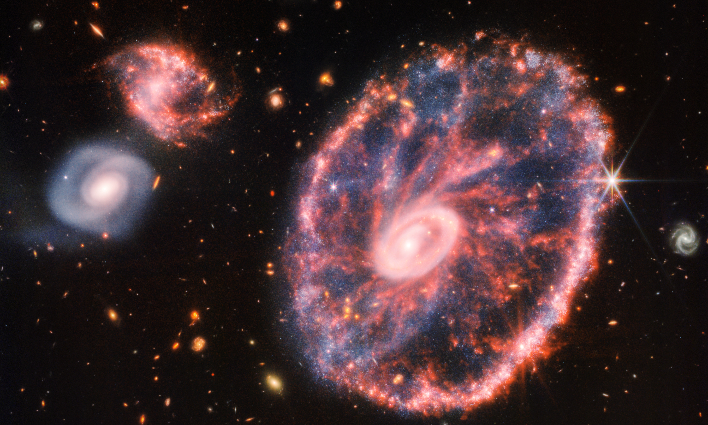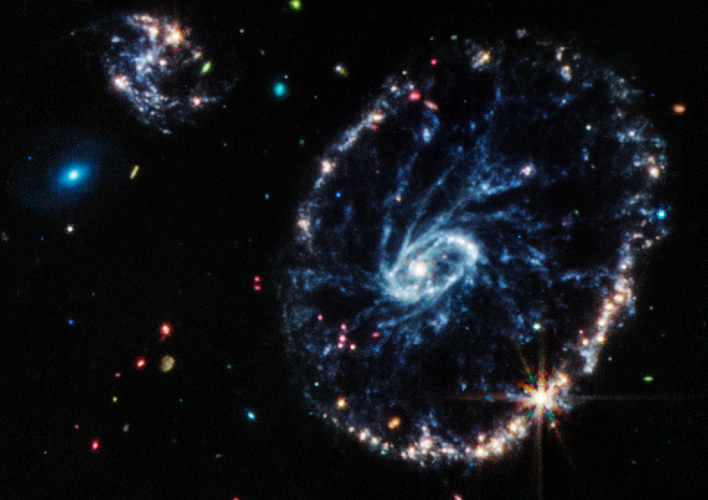NASA's Space Telescope Shot Of The Cartwheel Galaxy Will Leave Your Head Spinning
NASA's James Webb Space Telescope (JWST) continues to produce spectacular images from deep space. One of its latest pictures shows the chaos of the Cartwheel Galaxy, revealing new data surrounding star formation and the galaxy's central black hole.
The Hubble telescope is still producing awe inspiring imagery of space, but its new companion, JWST, is beginning to unveil new information as it captures details never seen before. Webb's Near-Infrared Camera (NIRCam) and Mid-Infrared Instrument (MIRI) recently produced images of the Cartwheel Galaxy, located 500 million light-years away in the Sculptor constellation.
The Cartwheel Galaxy is much like that of a wagon wheel in its appearance. Its design is the result of a high-speed collision between a large spiral galaxy and a smaller galaxy which is not visible in the recent images by Webb. An effect of the collision is the galaxy's two rings, a bright inner ring and a surrounding, colorful ring. The two rings extend outward from the center of the collision, much like ripples in a pond after a rock is tossed into it, according to NASA. Astronomers call galaxies of this nature a "ring galaxy," which are less common than spiral galaxies.
At its core, the galaxy consists of hot dust with the brightest areas being home to gigantic young star clusters. The outer ring, which has been expanding over the last 440 million years, is dominated by star formation and supernovas. As the ring continues to expand outward, it interacts with surrounding gas and triggers star formation.
The image above was taken by Webb's Mid-Infrared Instrument. MIRI data is colored red in the image and reveals regions within the Cartwheel Galaxy rich in hydrocarbons and other chemical compounds. It is these regions that form the spiraling spokes that make up the galaxy's skeleton. While these spokes were first observed via Hubble observations, Webb is able to view them in a more prominent manner.
The new observations by JWST of the Cartwheel Galaxy emphasize that it is in a very transitory stage. It is presumed that it was once a spiral galaxy much like our own Milky Way, before its collision began its transformation and is expected to continue transforming. Webb's snapshots give scientists and astronomers an insight into what happened to the galaxy in the past, and how it might evolve in the future.
You can view these images on NASA's Instagram page, as well as past and future images from the iconic space telescope.
Top Image Credit: NASA/ESA/CSA
The Hubble telescope is still producing awe inspiring imagery of space, but its new companion, JWST, is beginning to unveil new information as it captures details never seen before. Webb's Near-Infrared Camera (NIRCam) and Mid-Infrared Instrument (MIRI) recently produced images of the Cartwheel Galaxy, located 500 million light-years away in the Sculptor constellation.
The Cartwheel Galaxy is much like that of a wagon wheel in its appearance. Its design is the result of a high-speed collision between a large spiral galaxy and a smaller galaxy which is not visible in the recent images by Webb. An effect of the collision is the galaxy's two rings, a bright inner ring and a surrounding, colorful ring. The two rings extend outward from the center of the collision, much like ripples in a pond after a rock is tossed into it, according to NASA. Astronomers call galaxies of this nature a "ring galaxy," which are less common than spiral galaxies.
At its core, the galaxy consists of hot dust with the brightest areas being home to gigantic young star clusters. The outer ring, which has been expanding over the last 440 million years, is dominated by star formation and supernovas. As the ring continues to expand outward, it interacts with surrounding gas and triggers star formation.
The image above was taken by Webb's Mid-Infrared Instrument. MIRI data is colored red in the image and reveals regions within the Cartwheel Galaxy rich in hydrocarbons and other chemical compounds. It is these regions that form the spiraling spokes that make up the galaxy's skeleton. While these spokes were first observed via Hubble observations, Webb is able to view them in a more prominent manner.
The new observations by JWST of the Cartwheel Galaxy emphasize that it is in a very transitory stage. It is presumed that it was once a spiral galaxy much like our own Milky Way, before its collision began its transformation and is expected to continue transforming. Webb's snapshots give scientists and astronomers an insight into what happened to the galaxy in the past, and how it might evolve in the future.
You can view these images on NASA's Instagram page, as well as past and future images from the iconic space telescope.
Top Image Credit: NASA/ESA/CSA



